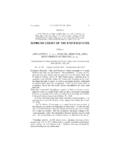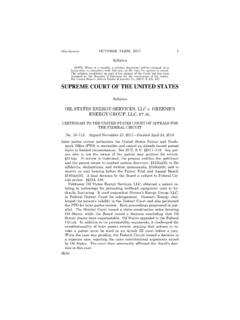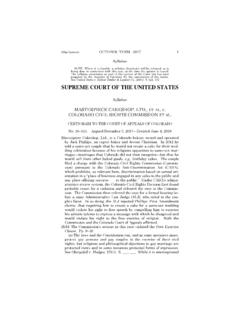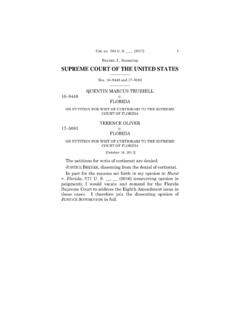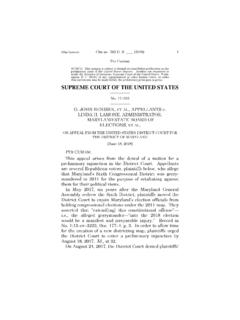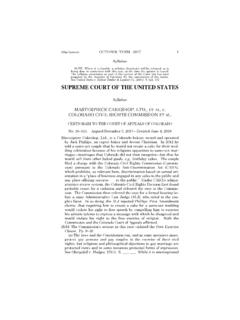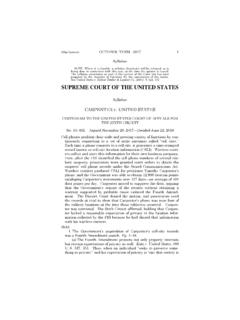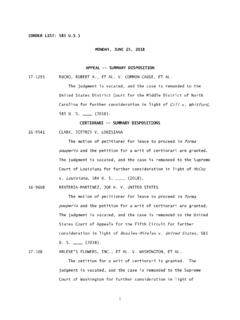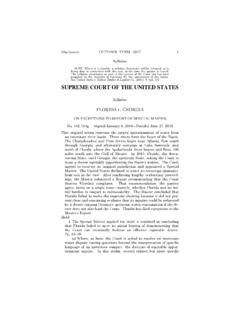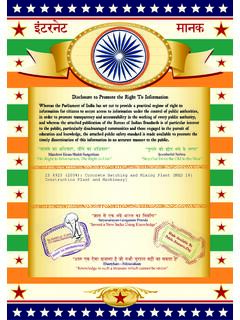Transcription of SUPREME COURT OF THE UNITED STATES
1 1 (Slip Opinion) OCTOBER TERM, 2020 Syllabus NOTE: Where it is feasible, a syllabus (headnote) will be released, as is being done in connection with this case, at the time the opinion is issued. The syllabus constitutes no part of the opinion of the COURT but has been prepared by the Reporter of Decisions for the convenience of the reader. See UNITED STATES v. Detroit Timber & Lumber Co., 200 U. S. 321, 337. SUPREME COURT OF THE UNITED STATES Syllabus UNITED STATES v.
2 COOLEY CERTIORARI TO THE UNITED STATES COURT OF APPEALS FOR THE NINTH CIRCUIT No. 19 1414. Argued March 23, 2021 Decided June 1, 2021 Late one night Officer James Saylor of the Crow Police Department ap-proached a truck parked on UNITED STATES Highway 212, a public right-of-way within the Crow Reservation in the State of Montana. Saylorspoke to the driver, Joshua James Cooley, and observed that Cooleyappeared to be non-native and had watery, bloodshot eyes. Saylor alsonoticed two semiautomatic rifles lying on Cooley s front seat. Fearingviolence, Saylor ordered Cooley out of the truck and conducted a patdown search.
3 Saylor also saw in the truck a glass pipe and a plasticbag that contained methamphetamine. Additional officers, including an officer with the federal bureau of Indian Affairs, arrived on the scene in response to Saylor s call for assistance. Saylor was directed to seize all contraband in plain view, leading Saylor to discover more methamphetamine. Saylor took Cooley to the Crow Police Department where federal and local officers further questioned Cooley. Subse-quently, a federal grand jury indicted Cooley on drug and gun offenses.
4 The District COURT granted Cooley s motion to suppress the drug evi-dence. The Ninth Circuit affirmed. It reasoned that a tribal policeofficer could stop (and hold for a reasonable time) a non-Indian suspect if the officer first tries to determine whether the suspect is non-Indian and, in the course of doing so, finds an apparent violation of state orfederal law. The Ninth Circuit concluded that Saylor had failed tomake that initial determination here. Held: A tribal police officer has authority to detain temporarily and to search non-Indian persons traveling on public rights-of-way running through a reservation for potential violations of state or federal law.
5 Pp. 3 9.(a) As a general proposition, the inherent sovereign powers of anIndian tribe do not extend to the activities of nonmembers of the tribe. 2 UNITED STATES v. COOLEY Syllabus Montana v. UNITED STATES , 450 U. S. 544, 565. The COURT identified in Montana two exceptions to that general rule, the second of which fits almost like a glove here: A tribe retains inherent authority over the conduct of non- indians on the reservation when that conduct threat-ens or has some direct effect on.
6 The health or welfare of the tribe. Id., at 566. The conclusion that Saylor s actions here fall within Mon-tana s second exception is consistent with the COURT s prior Montana cases. See Strate v. A 1 Contractors, 520 U. S. 438, 456 n. 11; see also Atkinson Trading Co. v. Shirley, 532 U. S. 645, 651. Similarly, the COURT has held that when the jurisdiction to try and punish an of-fender rests outside the tribe, tribal officers may exercise their power to detain the offender and transport him to the proper authorities.
7 Duro v. Reina, 495 U. S. 676, 697. Ancillary to the authority totransport a non-Indian suspect is the authority to search that individ-ual prior to transport, as several state courts and other federal courtshave held. While that authority has sometimes been traced to a tribe sright to exclude non- indians , tribes have inherent sovereignty inde-pendent of th[e] authority arising from their power to exclude, Bren-dale v. Confederated Tribes and Bands of Yakima Nation, 492 U. S. 408, 425 (plurality opinion), and here Montana s second exception rec-ognizes that inherent authority.
8 In addition, recognizing a tribal of-ficer s authority to investigate potential violations of state or federallaws that apply to non- indians whether outside a reservation or on a public right-of-way within the reservation protects public safety with-out implicating the concerns about applying tribal laws to non- indians noted in the COURT s prior cases. Finally, the COURT doubts the worka-bility of the Ninth Circuit s standards , which would require tribal of-ficers first to determine whether a suspect is non-Indian and, if so, totemporarily detain a non-Indian only for apparent legal F.
9 3d 1135, 1142. The first requirement produces an incentive to lie. The second requirement introduces a new standard into search and seizure law and creates a problem of interpretation that will arisefrequently given the prevalence of non- indians in Indian 3 7.(b) Cooley s arguments against recognition of inherent tribal sover-eignty here are unpersuasive. While the COURT agrees the Montana exceptions should not be interpreted so as to swallow the rule, Plains Commerce Bank v. Long Family Land & Cattle Co., 554 U.
10 S. 316, 330, this case does not raise that concern due to the close fit be-tween Montana s second exception and the facts here. In addition, the COURT sees nothing in existing federal cross-deputization statutes that suggests Congress has sought to deny tribes the authority at issue. To the contrary, existing legislation and executive action appear to oper-ate on the assumption that tribes have retained this authority. Pp. 8 9. 3 Cite as: 593 U. S. ____ (2021) Syllabus 919 F. 3d 1135, vacated and remanded. BREYER, J., delivered the opinion for a unanimous COURT .
